
Young American Patriots

Remember...
Roy Woodrow Stemple
1919-1945
"No man is entitled to the blessings of freedom unless he be vigilant in its preservation."
General Douglas MacArthur
 Young American Patriots |
Remember...Roy Woodrow Stemple
|
Roy Woodrow Stemple was born on October 4, 1919, to Amos C. and Lilly Wotring Stemple. According to the 1930 Federal Census, the family was living in the Union Magisterial District in Preston County. The household included both parents and their children, Paul, Bertha Schrock (presumably the daughter's married name), Elmer, Kathryn, and Roy. An older son, Frank, seems to not have been living at home at the time of the census. Mr. Stemple was a farmer, and son Paul was a public school teacher. On the same census page were other Stemple families. In 1940, according to the census, Mr. Stemple was still farming, Mrs. Stemple had no employment outside the home, and only their son, Roy, was still living at home.
When Roy Stemple registered with the selective service, he was a graduate of Aurora High School and had gone on to West Virginia University. According to a death notice for him, which appeared in the Preston County Journal on March 8, 1945, Roy Stemple had graduated from the university. No record was located that noted what he majored in. Japan had already attacked the Philippines and was well on its way to routing the United States forces from the islands in 1941 and 1942. Roy Stemple entered the Army in August 1942 at Fort Hayes, Columbus, Ohio. Roy Stemple was a Tech 5 (corporal), a member of the 1st Infantry, 6th Division. Technician fifth grade means that he possessed a specialized skill, and, during World War II, was probably called "Tech Corporal Stemple."
Japan attacked the Philippines in 1941, defeating U.S. and Philippine forces and taking the islands for themselves in 1942. Japan occupied the Philippines as protection for itself. The United States had bases and aircraft there, a threat to the Japanese. Occupying the islands ensured that any hostile forces wishing to take the war to Japan first had to defeat interceptions launched from the islands. There were other reasons as well. Hostile forces occupying the Philippines might interfere with Japanese trade routes and with Japan�s access to materials that would be used to support the war. ("Why Did Japan Attack the Philippines, in 1941, Because of the Americans?" Quora, accessed 15 July 2018, https://www.quora.com/Why-did-Japan-attack-the-Philippines-in-1941-because-of-the-Americans; Ronald E. Dolan, ed., "World War II," Philippines: A Country Study, [Washington, DC: Library of Congress, 1991], accessed 15 July 2018, http://countrystudies.us/philippines/21.htm.) It became a milestone for the United States to defeat the Japanese in the Philippines and re-take the military bases.
Other sources provide a look at the strategic importance of the Philippines in World War II. General Douglas MacArthur's promise to return to the islands made them a focus of the war in the Pacific, maintaining the morale of the U.S. troops as well as the Philippine people. According to one source, referring to October 20, 1944:
After advancing island by island across the Pacific Ocean, U.S. General Douglas MacArthur wades ashore onto the Philippine island of Leyte, fulfilling his promise to return to the area he was forced to flee in 1942. ("MacArthur Returns," History.com, 2010, accessed 15 July 2018, https://www.history.com/this-day-in-history/macarthur-returns.)
From another source, in 1945:
These American victories on land and sea at Leyte opened the door for the landing of more than 60,000 American troops on Luzon on January 9. Once again, cameras recorded MacArthur walking ashore, this time to greet cheering Filipinos. Although the American troops met little opposition when they landed, they lost the light cruiser Columbia and the battleship Mississippi, to kamikazes, resulting in the deaths of 49 American crewmen.The initial ease of the American fighters' first week on land was explained when they discovered the intricate defensive network of caves and tunnels that the Japanese created on Luzon. The intention of the caves and tunnels was to draw the Americans inland, while allowing the Japanese to avoid the initial devastating bombardment of an invasion force. Once Americans reached them, the Japanese fought vigorously, convinced they were directing American strength away from the Japanese homeland. Despite their best efforts, the Japanese lost the battle for Luzon and eventually, the battle for control over all of the Philippines. ("United States Invades Luzon in Philippines [1945]," This Day in History, History.com, 2009, accessed 15 July 2018, https://www.history.com/this-day-in-history/united-states-invades-luzon-in-philippines.)
Roy Stemple's life was lost on January 27, 1945, on Luzon. Following the historic accounts of the actions taken by his unit, it's possible that he died during the battle to take Clark Field. Clark Field, and the area around it, was held by 30,000 Japanese troops. United States forces began engagements there on January 23. Fighting continued until the end of January 1945 and ended with a United States triumph. ("Battle of Luzon," Wikipedia, 7 July 2018, accessed 15 July 2018, https://en.wikipedia.org/wiki/Battle_of_Luzon.)
According to an entry for Roy Stemple in Young American Patriots, he was trained at or served in Fort Leonard Wood, Missouri; Camp Obispo, California; Milne Bay, Maffiin Bay, New Guinea; Sansapor Coast; and Cagayan Hills, Bataan; however, the division chronicle ("6th Infantry Division: Sight Seein Sixth," US Army Divisions, accessed 16 July 2018, https://www.armydivs.com/6th-infantry-division/) indicates the unit didn't move to Bataan until February of 1945. His medals include a Purple Heart, three Bronze Stars, the American Victory Medal, the Good Conduct Medal, the Asiatic-Pacific Campaign Medal, and the Philippine Islands Liberation Medal.
Article prepared by Cynthia Mullens
July 2018

West Virginia Archives and History welcomes any additional information that can be provided about these veterans, including photographs, family names, letters and other relevant personal history.